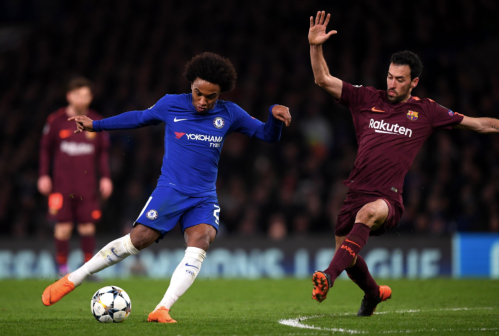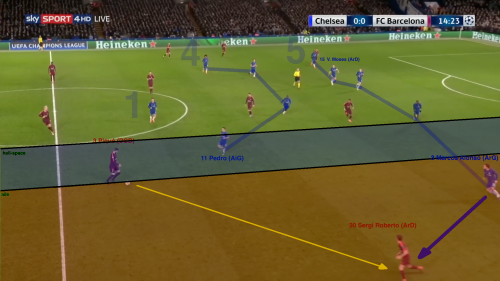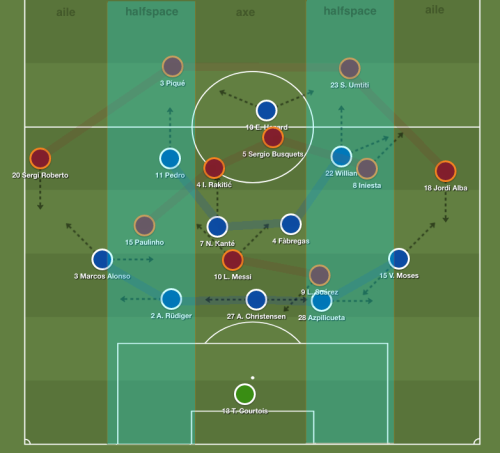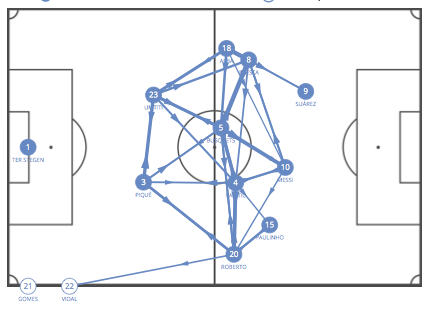That being said, in this very low set-up, Chelsea didn’t enjoy a lot of solutions forward when they won the ball back. Blues recover most of Barça’s possessions in their own last 1/3 of the pitch (51%), Barça only did this 27% of the time.
They would eventually suffer the consequences of this problem on Messi’s goal, after Christensen sloppy pass to Fabregas in the center of the pitch. They were actual solutions on the other wing (Moses and Azpi) but they were very risky. Barça’s quality makes you pay cash for your lack of lucidity in those areas of the pitch.
Low offensive transition a theoretical weak point of Chelsea in 5-4-1, and United somehow took advantage of that on their equalizer on Sunday:

Chelsea is once again paying for their weakness in low transition: Drinkwater tries to clear the ball, but the offensive transition is squeezed by Lukaku, as United were man marking Chelsea’s inside wingers.
Willian’s positional superiority
With 8 or 9 players in low position at the time they recovered the ball, the aim (or rather, the obligation) of Chelsea was to find the opposite winger in the half-space on offensive transition.

Willian intercepts, he then has no other option than Hazard to play forward
On these defensive transition situations, Catalans found themselves in big trouble.
They enjoyed a large numerical superiority, but Willian, Pedro and Hazard intermediate positioning (between the 4 defenders) were preventing them from intervening to cut the counter attack and counter press with efficiency.
Roles were not clearly defined on Barça’s defensive transition, and Chelsea could escape the trap.

Chelsea offensive transition before Willian’s first shot on the post (33’): Willian’s pass to Hazard is extra-predictable (only option), but Belgium man is gaining advantage from his freedom in the half-space, between Pique and Sergi Roberto. He would then be able to create chaos.
As Barça’s defence could not intervene, they ended up stepping back. Chelsea could then set up offensively in Barça’s half and create chaos, as they did on Willian’s shots on the post.
This schema was extra-predictable for Barça, but still, it worked.
Chelsea could then move to positional play in opposite side, pointing other structural problems for Barça.
Barça defended too low
As seen in the video above, Barça faced the same issues as any 4231/442 defensive block against Conte’s 3-4- 3 / 3-2-5 (including Tottenham, at the Bridge last season)

Big structural problems for Chelsea’s opposition in zonal 442: 5 attackers are placed in between Barça’s defence, and a 3v2 situation takes place against Messi and Suarez. Barça’s defender are having a hard time at changing markings
On positional play, Chelsea set up in some kind of 3-2-5. At the time Alba attacks Moses, Umtiti and Pique then find themselves in a 2v2 situation against Hazard and Willian.

Rudiger takes advantage of his freedom to progress. Sergi Roberto is attracted to Alonso at wide. Pique cannot attack Pedro, or he will leave Hazard and Umtiti in 1v1
At this moment, Catalan defenders naturally do not dare to go up and play offside trap, thus shutting the door to the 16 yards box. This problem could have led to a penalty when Umtiti locked arms around Hazard in the box.
Rakitic – Busquets double pivot and (both) transitions
The second hit by Willian came after a free kick played quick by Chelsea, after another successful transition by Chelsea.
Once again, Barça’s are structurally inconvenienced by Chelsea’s 3-2-5: Rakitic and Busquets defend on the same horizontal line. When Sergi Roberto tries to clear the ball, both Busquets nor Rakitic can cover; and then Willian gets the second ball.
This positioning also affected defensive transition and defensive animation. A good vertical pass, or a dribble and then Busquets and Rakitic were both beaten, and the defenders were on their own.
Chelsea must validate, Barça must adapt
Chelsea spent most of the time defending low against Barça, but still, low transition remain the only in aspect in which they really struggled.
Intermediate positioning of Conte’s forwards caused a lot of problems to Barça defensive transition and defensive animation. Sergi Roberto and Alba went trough the same ordeal as many wingbacks against Conte’s system, conceived to escape their marking and make them useless.
To make history in Barcelona, Blues must first repeat their defensive performance. Then, they’ll have to build on their offensive achievements to score the away goal that would reshuffle the cards in Camp Nou.
Barça will have to have a better plan to control Willian, Hazard and (or) Pedro in half-spaces, in order to be more efficient in defensive phases, and defensive transition.
Victor Lefaucheux











